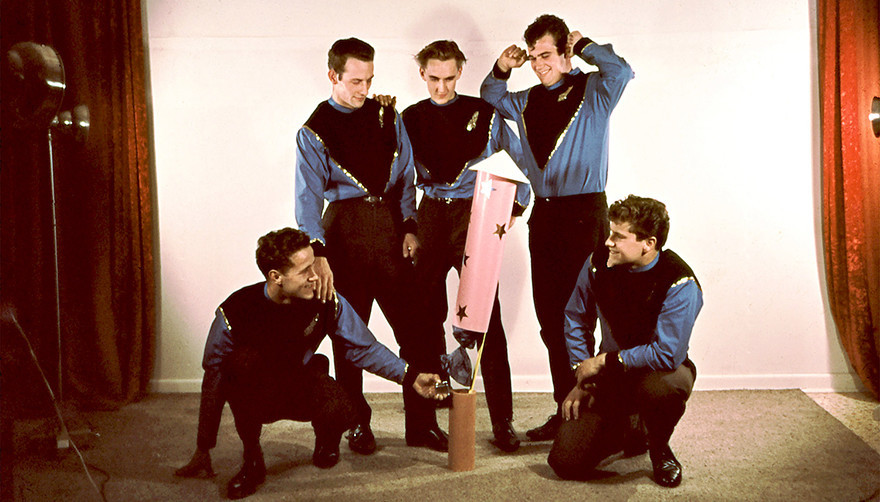
The Rockets pose for a publicity photo, with Keith Richardson at back left. - Keith Richardson Estate
Hawke’s Bay had a lively rock community in the 1960s. I’ve already written about The Rockets, who played at dances around the Bay and backed Mr Lee Grant at some of his early gigs. They had three record releases on Pacific (out of Dannevirke) and one on HMV. I also wrote about Johnny and the Contacts, which was formed to open the Top Hat ballroom and were resident there for eight years. See also Lee Pritchard’s story on the Top Hat, which was the premier venue in the Bay for many years. But there were many other venues around the Bay, with both Napier and Hastings described in separate AudioCulture story maps by Glen Moffatt.
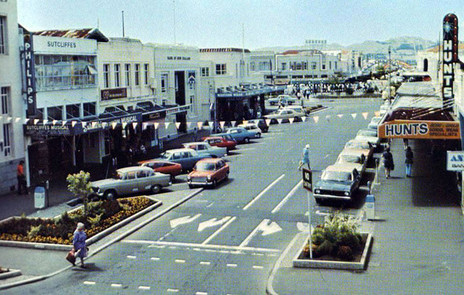
Sutcliffe's Music Store, Heretaunga Street West, Hastings, visible at left in this 1963 photo.
Sutcliffe’s Music Store in Hastings was very supportive of the music scene. The store was part-owned by John Mullany, who also fronted a group that played at balls and dances. The shop employed many musicians. The piano workshop in the back of the shop had a control room along one wall. This was Soundex studio, and the pianos were wheeled to one side so bands could set up their gear and record their material. The earliest Rockets records were made there, with ‘Gonzales’ making the charts: No.16 on the Auckland Top 20 and No.30 on the Christchurch Hot 100. This studio was used in 1964 to record a series featuring local groups for 2ZC, All Our Own, produced by DJ Keith Richardson and sponsored by Sutcliffe’s.
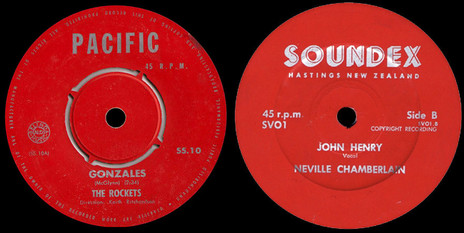
Left: The Rockets' 'Gonzales' on the Pacific label, 1961; at right, Hawke's Bay DJ Neville Chamberlain's version of 'John Henry', recorded at Soundex, 1960.
Following the success of All Our Own, in 1967 there was a further series sponsored by Sutcliffe’s: Switched On Scene, a series of 15-minute programmes of local rock groups, was broadcast once only on 2ZC, once a week in the early evening. This time all the groups were recorded in the 2ZC studios; I was the sound engineer, and Keith Richardson the producer.
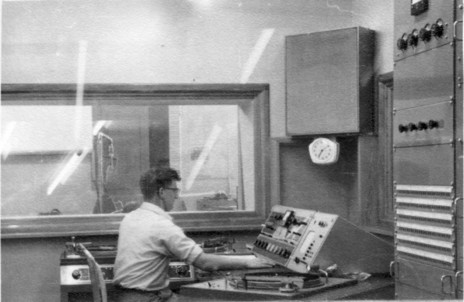
David Lindsay at the desk in 2ZC's broadcast suite. - David Lindsay Collection
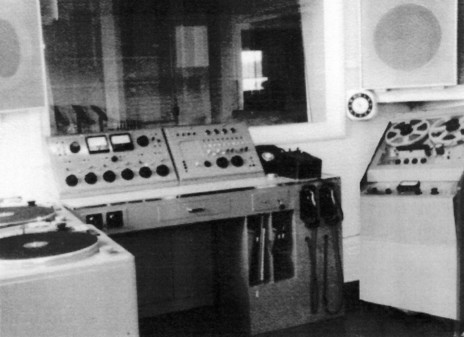
The basic control room of the 2ZC studio where the bands were recorded. Only six unequalised channels and mono Ampex 350 reel-to-reel recorders. The studio is through the window. - David Lindsay
By today’s standards, the set-up was rather basic. The recorders were mono reel-to-reel Ampex 350s. The mixing desk only had six non-equalised channels. The technique employed was to record the band only on the first run, then play that back and add the vocals on the second run. There was primitive echo available by sending a feed of the vocals into the concrete-walled stairwell and picking up the reverb with an extra microphone (hoping there was no one on the stairs at the time!)
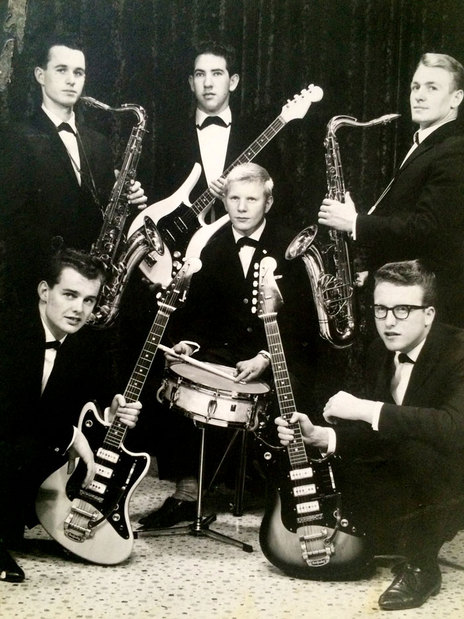
The original Johnny and The Contacts line-up. Top (L-R): Paul Gitmans, Mike Angland, Noel Morley. Below (L-R): Melvin Gardener, Johnny Dick, John “Mac” Walker.
Many of these recordings still exist and remain a good example of the standard achieved in the days before the pub scene took over. Johnny and The Contacts were represented in both series.
To tie in with the digital release of other groups in the 1967 series, what follows is a thumbnail sketch of the rock bands included. In most cases, this is the first time this music has been heard by the general public since that one broadcast.
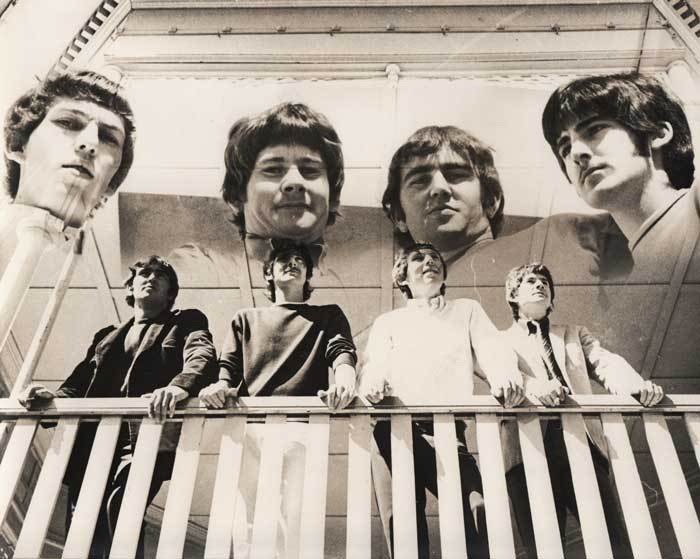
The Deep Set/Troubled Minds. Top (L-R): Len Whittle, Johnny Banks, Bob Jackson, Dick Roberts. Below (L-R): Bob Jackson, Dick Roberts, Len Whittle, Johnny Banks. - Keith Richardson estate.
Probably the most well-known are The Deep Set. This group evolved out of the Len Whittle Combo, which in 1965 was a five-piece jazz-type group that played at the Plainsman Coffee Lounge and the Top Hat. After a change of several members their style changed to Animals-style rhythm and blues – and their name changed to the Deep Set. In 1967 they recorded four original numbers, ‘The Devil is a Woman’, ‘Finders Keepers’, ‘Child’, and ‘Living It Down’. The line-up for this session was Dick Roberts (vocals/percussion), Bob Jackson (lead guitar), Len Whittle (keyboards), John Banks (drums), and Ian Rowe (bass).
Dick Roberts recalls: “On the back of these recordings, Keith Richardson took us to the HMV studio in Wellington to record a demo for the Viking label of ‘Living It Down’. But it was rejected for drug references! It left us wondering, ‘WTF’. My line ‘Since I took a trip I’ve been living it down’ at the time referenced a road trip in secluded 1966 Hawke’s Bay. We had never heard of acid – let alone tried it!”
Later in 1967 the group changed their name once again to Troubled Minds, moved to Auckland to further their career, and became successful in the dance hall and club scene. Ian Rowe left the band and Len Whittle took over the bass line on his newly bought Farfisa Duo. Bob Jackson left on the cusp of the C’mon ’68 tour and Bruce “Phantom” Robinson took the guitar spot. Len Whittle left after that tour, and Derek Fitzgerald covered the keyboard slot.
They were the Troubled Minds until after the C’mon ’68 tour when Ray Columbus, their new manager, decided they should be a collective (it was the thing back in the States) so dropped the “s”. Dick Roberts wasn’t keen, however Troubled Mind pushed on with new members John Coker on bass and Roger Williams on Hammond organ. The members of the band went their separate ways late in 1968.
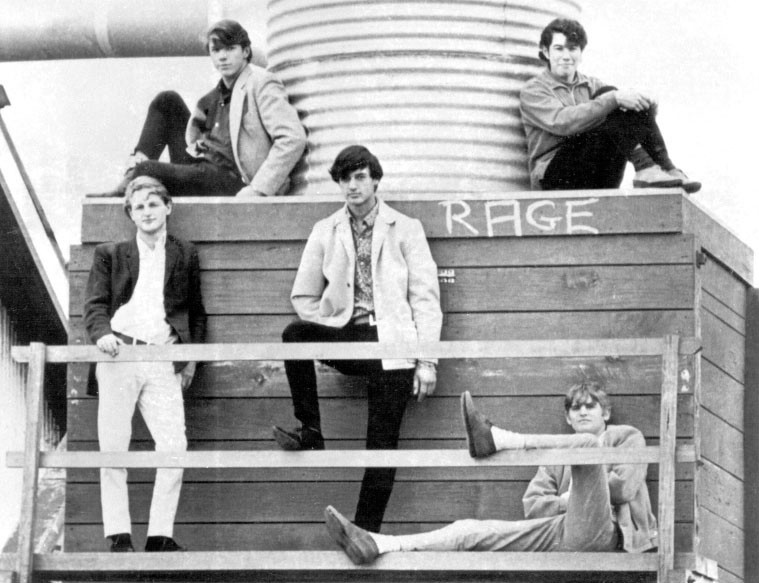
Rage. Top (L-R): Grant Calgey, Bill Watford. Below: John Olsen, Tristan David, Ronnie Atkin. - Photo by Grant Calgey
Rage were Grant Calgey (vocals), Bill Walford (lead guitar), Tristan David (keyboards), Ron Atkin (drums), and John Olsen (bass). Some of the venues they played were the Top Hat, the Miss Hawke’s Bay Show at the Municipal Theatre in 1967, the old “lodge” rooms at the bottom of Milton Road, a Gisborne nightclub called the Penthouse, and various other public dances. They are represented by covers of ‘Dr Robert’, ‘See See Rider’, and ‘I Take What I Want’.
In August 2023, ‘Dr Robert’ is one of three tracks from New Zealand groups included in a UK released three-CD box set featuring Beatles songs by cover groups. As vocalist Grant Calgey commented when told of the late fame: “‘Dr Robert’ wasn't a high-profile Beatles song, but we liked it. We were just kids back then.”
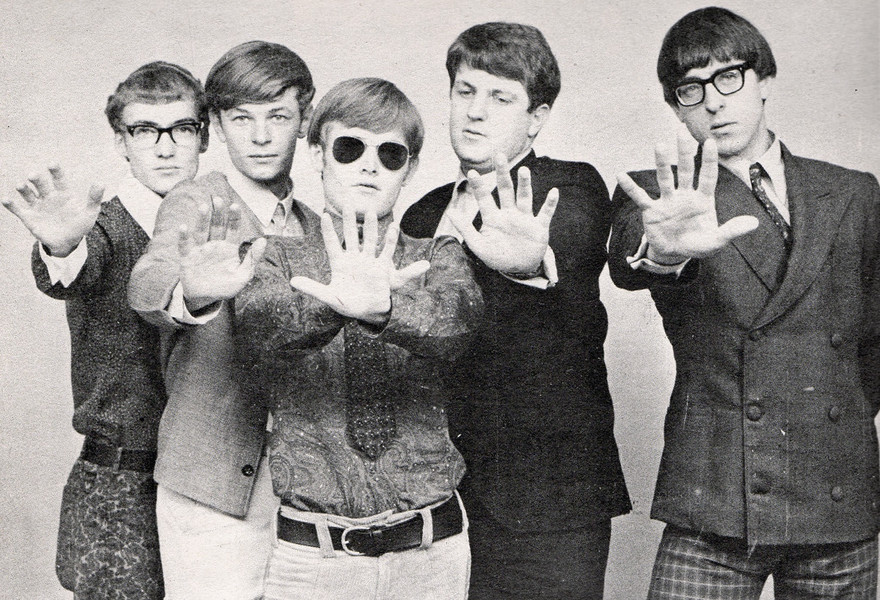
An early photo of The Hand: Geoff Bainbridge, Simon Heath, Ray Fidler, Alan Sargison, Al Dawson. - Photo: Geoff Bainbridge
The Hand were Ray Fidler (vocals), Al Dawson (lead guitar), Simon Heath (rhythm guitar), Alan Sargison (bass), and Colin McRae (drums). Colin joined the group in May 1967 when previous drummer Geoff Bainbridge fell sick, and Colin played with the group through to January/February, after which he went off to university. Pubs had started opening late by this time and Ray Fidler had drifted off to join the Ernie Rouse Trad Band.
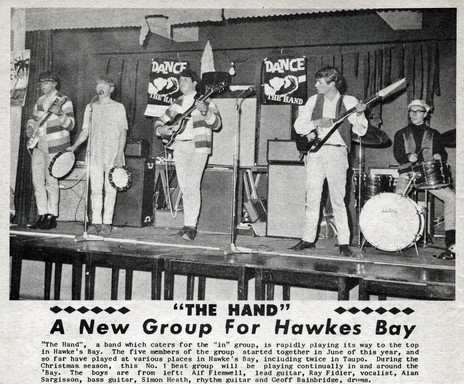
The Hand in Hawke's Bay Photo News, Nov 1966.
In addition to recording a version of The Monkee’s ‘I’m Not Your Stepping Stone’, The Hand are represented on the digital release by covers of The Kinks’ ‘Don’t Ever Change’, ‘Most Exclusive Residence’ and Cream’s ‘N.S.U.’. The Hand continued to play around the Bay into the 1980s.
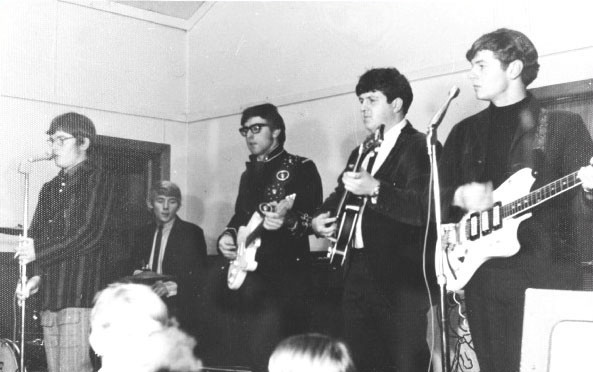
The Hand (as featured on the recordings): Ray Fidler, Colin McRae, Al Dawson, Alan Sargison, Simon Heath. - Photo: Colin McRae
The Identity were a bit of a mystery. They came into the studio, impressed us with their Leslie rotating speaker, sang four numbers, then disappeared without trace. Proof of their existence lies in the songs: originals ‘Just Out Of Reach’ and ‘In Her Power’, and covers of ‘Funny Feeling’ and ‘Give It To Me’.
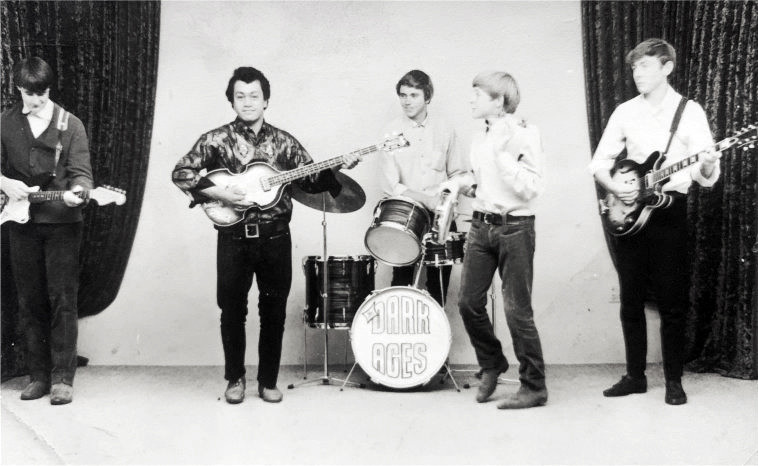
The Dark Ages: Bill Roydhouse, Ni Keefe, Ray Bryant, Ian Roydhouse, John Owen. - Photo: Bill and Ian Roydhouse
The Dark Ages – not to confused with the Auckland group of the same name who recorded one single for the Red Rooster label – are represented by only one number, Otis Redding’s ‘Security’.
The Dark Ages’ line-up was Ian Roydhouse (vocals), Bill Roydhouse (lead guitar), John Owen (rhythm guitar), Ni Keefe (bass) and Ray Bryant (drums). They were together for about four years and had a regular gig at the Majestic Ballroom. Other venues were the Plainsman Coffee Lounge and the Taradale Town Hall. (In their early days the group used to watch Johnny and The Contacts at the Top Hat to work out what chords they were playing.) They broke up once the pub scene reduced the number of dances being held.
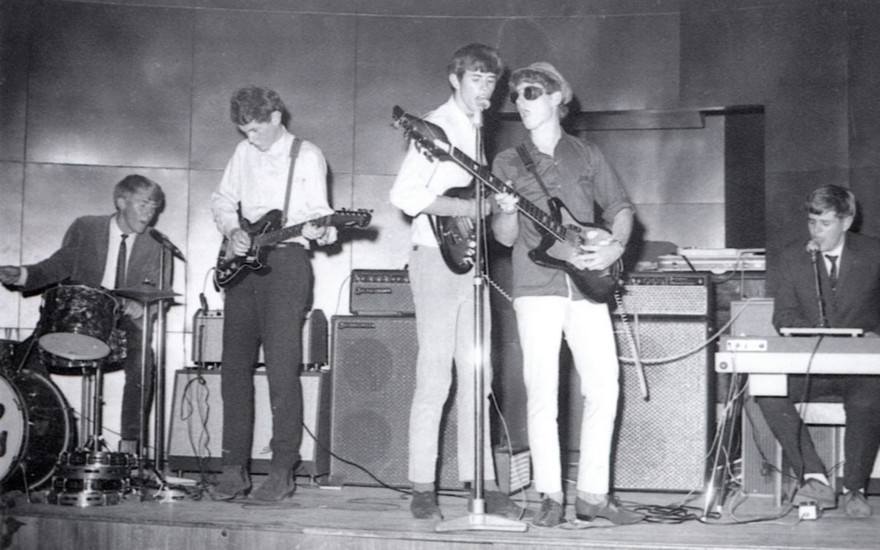
Limited Company. From left: Colin McRae, Bob Boniface, Max Saunders, Russell Ross, Wayne Mills. - Photo: Max Saunders
The members of Limited Company were all in the same class at Colenso High School and would have been around 16 years old at the time. They were: Max Saunders (rhythm guitar), Bob Boniface (lead guitar), Wayne Mills (keyboards), Colin McRae (drums), and Russell Ross (bass).
Max does the vocals on ‘I’m Crying’. On ‘Don’t Whistle At Me Baby’, Wayne takes the vocal and Russell plays euphonium. The group played at the Cabaret Cabana, the Napier War Memorial Hall and the Red Cross Hall, among other venues. Colin McRae also played with The Hand (see above). They all went off to university in 1969. Max later went on to play for three years with Midge Marsden’s band.
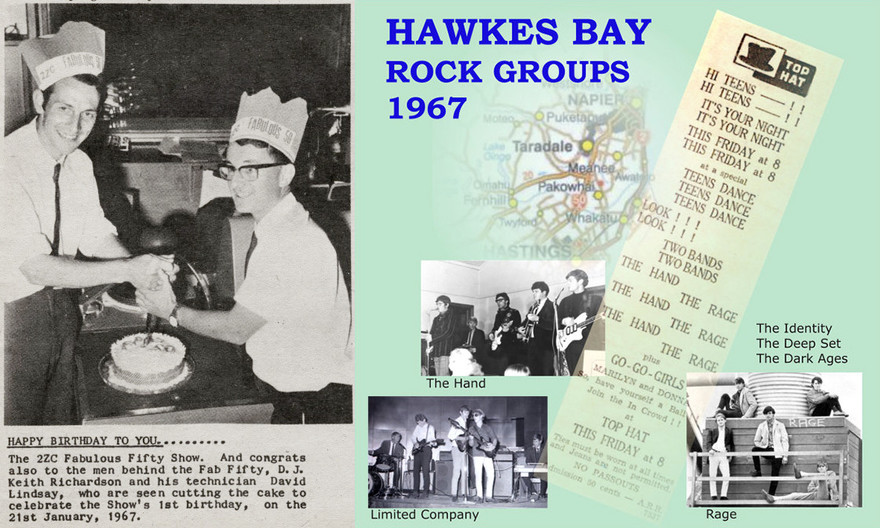
At left: "Happy birthday to you ... The 2ZC Fabulous Fifty Show" Keith Richardson and David Lindsay celebrate the programme's first birthday (Hawke's Bay Photo News, February, 1967). At right: Hawke's Bay Rock, 1967 - the compilation of the 2ZC recordings available on Spotify.